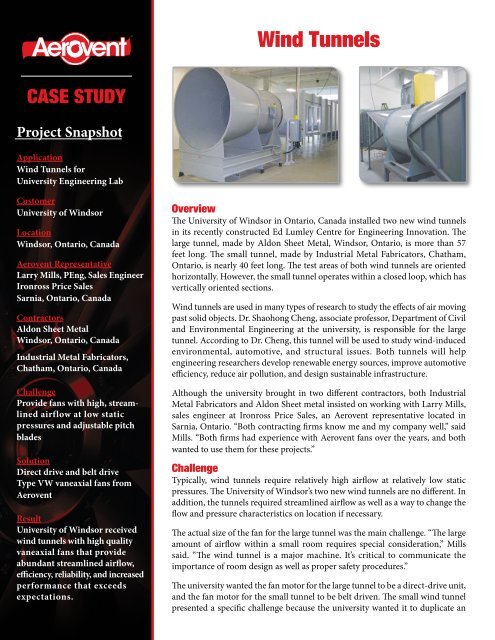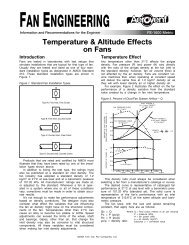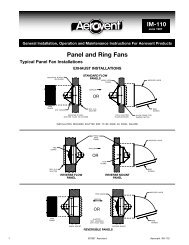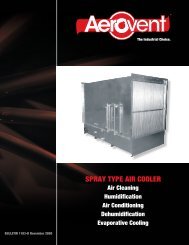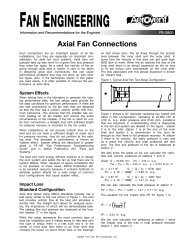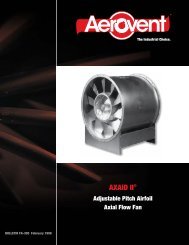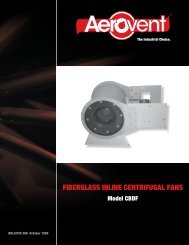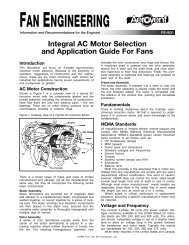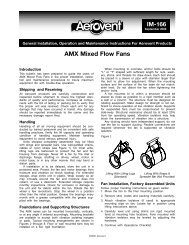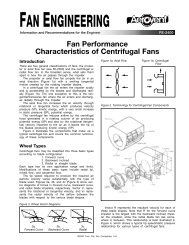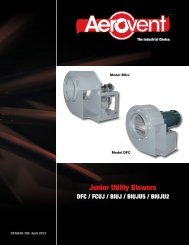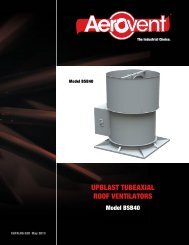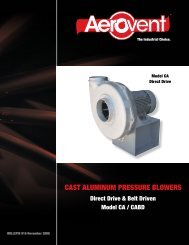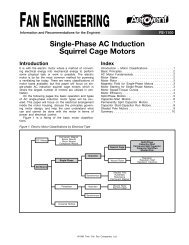Wind Tunnels - Aerovent
Wind Tunnels - Aerovent
Wind Tunnels - Aerovent
Create successful ePaper yourself
Turn your PDF publications into a flip-book with our unique Google optimized e-Paper software.
®<br />
<strong>Wind</strong> <strong>Tunnels</strong><br />
CASE STUDY<br />
Project Snapshot<br />
Application<br />
<strong>Wind</strong> <strong>Tunnels</strong> for<br />
University Engineering Lab<br />
Customer<br />
University of <strong>Wind</strong>sor<br />
Location<br />
<strong>Wind</strong>sor, Ontario, Canada<br />
<strong>Aerovent</strong> Representative<br />
Larry Mills, PEng, Sales Engineer<br />
Ironross Price Sales<br />
Sarnia, Ontario, Canada<br />
Contractors<br />
Aldon Sheet Metal<br />
<strong>Wind</strong>sor, Ontario, Canada<br />
Industrial Metal Fabricators,<br />
Chatham, Ontario, Canada<br />
Challenge<br />
Provide fans with high, streamlined<br />
airflow at low static<br />
pressures and adjustable pitch<br />
blades<br />
Solution<br />
Direct drive and belt drive<br />
Type VW vaneaxial fans from<br />
<strong>Aerovent</strong><br />
Result<br />
University of <strong>Wind</strong>sor received<br />
wind tunnels with high quality<br />
vaneaxial fans that provide<br />
abundant streamlined airflow,<br />
efficiency, reliability, and increased<br />
performance that exceeds<br />
expectations.<br />
Overview<br />
The University of <strong>Wind</strong>sor in Ontario, Canada installed two new wind tunnels<br />
in its recently constructed Ed Lumley Centre for Engineering Innovation. The<br />
large tunnel, made by Aldon Sheet Metal, <strong>Wind</strong>sor, Ontario, is more than 57<br />
feet long. The small tunnel, made by Industrial Metal Fabricators, Chatham,<br />
Ontario, is nearly 40 feet long. The test areas of both wind tunnels are oriented<br />
horizontally. However, the small tunnel operates within a closed loop, which has<br />
vertically oriented sections.<br />
<strong>Wind</strong> tunnels are used in many types of research to study the effects of air moving<br />
past solid objects. Dr. Shaohong Cheng, associate professor, Department of Civil<br />
and Environmental Engineering at the university, is responsible for the large<br />
tunnel. According to Dr. Cheng, this tunnel will be used to study wind-induced<br />
environmental, automotive, and structural issues. Both tunnels will help<br />
engineering researchers develop renewable energy sources, improve automotive<br />
efficiency, reduce air pollution, and design sustainable infrastructure.<br />
Although the university brought in two different contractors, both Industrial<br />
Metal Fabricators and Aldon Sheet metal insisted on working with Larry Mills,<br />
sales engineer at Ironross Price Sales, an <strong>Aerovent</strong> representative located in<br />
Sarnia, Ontario. “Both contracting firms know me and my company well,” said<br />
Mills. “Both firms had experience with <strong>Aerovent</strong> fans over the years, and both<br />
wanted to use them for these projects.”<br />
Challenge<br />
Typically, wind tunnels require relatively high airflow at relatively low static<br />
pressures. The University of <strong>Wind</strong>sor’s two new wind tunnels are no different. In<br />
addition, the tunnels required streamlined airflow as well as a way to change the<br />
flow and pressure characteristics on location if necessary.<br />
The actual size of the fan for the large tunnel was the main challenge. “The large<br />
amount of airflow within a small room requires special consideration,” Mills<br />
said. “The wind tunnel is a major machine. It’s critical to communicate the<br />
importance of room design as well as proper safety procedures.”<br />
The university wanted the fan motor for the large tunnel to be a direct-drive unit,<br />
and the fan motor for the small tunnel to be belt driven. The small wind tunnel<br />
presented a specific challenge because the university wanted it to duplicate an
®<br />
existing tunnel. However, there were no nameplates on the equipment; therefore<br />
determining its parameters and characteristics was difficult, but not impossible.<br />
CASE STUDY<br />
“I was called in to check the existing tunnel to try to determine the airflow,” Mills<br />
said. “Without a nameplate, no one seemed to know the tunnel’s rating. I worked<br />
with the university to come up with an estimate of what it would do.”<br />
Fortunately, based on the company’s experience in calculating airflow, Industrial<br />
Metal Fabricators was able to establish a mock-up, which helped with the tunnel’s<br />
performance estimate. “We collaborated on a redesign of the ductwork to make<br />
the new small tunnel a little more streamlined,” said Mills.<br />
Solution<br />
Ironross Price Sales provided two Type VW vaneaxial fans, both from <strong>Aerovent</strong>.<br />
The 60-inch, 60-HP, 1,180 RPM fan for the large wind tunnel is a direct-drive<br />
unit capable of supplying up to 110,000 CFM and up to 0.7 inch static pressure.<br />
The 48-inch, 30-HP, 1,322 RPM fan for the small tunnel is a belt-driven unit<br />
capable of supplying more than 40,000 CFM and up to 2.75 inches static<br />
pressure. Fan motor speed for both tunnels is controlled through variable<br />
frequency drives. If it becomes necessary to change the flow and pressure<br />
characteristics of either tunnel, both fans are equipped with adjustable-pitch blades.<br />
Streamlined flow is a primary wind tunnel requirement. “A vaneaxial fan should<br />
be used when the application requires high air flow and low pressure,” said Mills.<br />
“So the <strong>Aerovent</strong> Type VW was the right fan for this job.”<br />
The <strong>Aerovent</strong> vaneaxial propeller is specially designed to work with guide vanes.<br />
The overall mechanical efficiency of vaneaxial fans is typically higher than other<br />
axial-flow fans. The guide vanes improve efficiency and pressure characteristics<br />
by converting rotational energy at the propeller discharge into useful work.<br />
Results and Benefits<br />
Aldon Sheet Metal, Industrial Metal Fabricators, and the university wanted to<br />
use <strong>Aerovent</strong> fans because of their high quality and reliability, according to Mills.<br />
“<strong>Aerovent</strong> is very well known for vaneaxial fans,” he said.<br />
When the small tunnel was commissioned, feedback from Industrial Metal<br />
Fabricators indicated that the fan ran smoothly throughout the motor’s frequency<br />
range. During proof of performance testing, air velocity reached 7,000 feet per<br />
minute (FPM), or 43,750 CFM, which is well above the design rating of 6,000<br />
FPM, or 37,500 CFM. The tunnel it replaced could only attain 4,600 FPM, or<br />
28,750 CFM. At the recommended full speed, the 30 HP motor current is only<br />
18A. The university is very pleased with the fan’s performance because it<br />
exceeded their expectations.<br />
<strong>Aerovent</strong><br />
5959 Trenton Lane N.<br />
Minneapolis, MN 55442<br />
763-551-7500<br />
www.aerovent.com<br />
Although the size of the large tunnel could potentially limit its use within a<br />
relatively small room, steps were taken to emphasize proper and safe operation.<br />
Instead of just delivering a high quality fan, Mills took the time to explain the<br />
special considerations that accompany equipment of this size and ways to deal<br />
with them to get the most from the investment.<br />
Because of the performance, quality, efficiency, and reliability of <strong>Aerovent</strong>’s<br />
vaneaxial fans, the University of <strong>Wind</strong>sor’s new wind tunnels will provide<br />
engineering professors, researchers, and students with improved and expanded<br />
testing capabilities.


